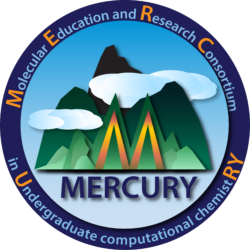
The 2022 annual MERCURY Conference for undergraduate computational chemistry was held July 20-22 at Furman University in Greenville, SC. Mainstays of the conference included six speakers providing background and specific findings in their respective fields, plus an undergraduate poster session and evening social networking events. This conference is an excellent forum for undergraduates to present their work and to learn from experts in the field, allowing them to put their own research into perspective. It is equally valuable as a networking event for faculty working with undergraduates. Undergraduates from all types of institutions are invited to come present their work.
Speakers
Thursday, July 21, 2022
Henry F. Schaefer III, University of Georgia

Monobridged A2H2 Structures:
A Micro-Chapter in the History of Main Group Inorganic Chemistry
Brenda Rubenstein, Brown University

Brenda Rubenstein is currently an Associate Professor of Chemistry at Brown University. She was named to Popular Science magazine’s 2021 Brilliant 10 list of the top early career scientists and C&EN’s 2019 Talented 12 list of early career chemists, and has received a number of research and teaching honors including the Camille Dreyfus Teacher Scholar Award, a Cottrell Teacher Scholar Award, and a Sloan Research Fellowship. While the focus of her work is on developing new electronic structure methods, she is also deeply engaged in rethinking computing architectures and computational biophysics.
Revealing the Mysteries of 2D Materials via Quantum Chemistry
Abstract: In recent years, 2D materials – atomically-thin materials like graphene that can be stacked to form complex structures with fascinating properties – have garnered a wealth of interest because of their unique low-dimensional physics, exotic magnetism, and the relative ease with which their properties can be tuned via doping, crinkling, strain, and stacking. Nonetheless, 2D materials can be challenging to characterize because of their limited thickness and the impact of substrates on their properties. This situation begs for simulations that can complement and resolve what experiments cannot resolve. In this talk, I will introduce you to the exciting world of 2D materials and demonstrate how quantum chemical methods can uniquely help researchers peer into 2D materials to uncover their atomic details and unprecedented array of properties. As illustrations, I will describe our recent work resolving the magnetism in some of the first discovered monolayer ferromagnets, CrI3 and NiPS3, which could not have been achieved without the unprecedented accuracy of modern-day quantum chemical techniques. I will also take the liberty to intersperse some anecdotes about my path through chemistry throughout this talk.
Reading List: Staros, D., Hu, G., Tiihonen, J., Nanguneri, R., Krogel, J., Bennett, M.C., Heinonen, O., Ganesh, P., Rubenstein, B., 2022. A combined first principles study of the structural, magnetic, and phonon properties of monolayer CrI3. The Journal of Chemical Physics 156, 014707. https://doi.org/10.1063/5.0074848
Mai-Anh Ha, National Renewable Energy Laboratory

Mechanistic Implications of the Heterogeneous Surface in Renewable Energy
Pt- and Ir-based catalysts remain the baseline catalysts for fuel cells and electrolyzers, often offering the greatest balance of activity and durability with >60% efficiency; these catalysts are also prohibitively expensive with Ir being even more precious than Pt, costing up to 5x more than Pt at >$6200/ozt. Fundamental understanding of how intrinsic material properties arise from the frequently non-equilibrium surface morphology of catalyst materials can allow us to identify how to optimize both well-known and developing materials. The interplay of facet dependence and redox conditions leading to oxide skins on metals combined with the many possible adsorption configurations of reaction intermediates can result in unique catalytic properties such as lowered activation barriers and bonding motifs. Rather than catalytic properties being defined by a single intermediate evolving under one mechanistic pathway, the statistical ensemble of accessible intermediates more accurately reflects a material’s catalytic properties to evolve products along multiple pathways. As theory approaches more realistic surface heterostructures and captures the multiplicity of adsorption configurations and sites, it can compliment, inform, and even predict macroscopic properties observed in experiment: case studies include Borated-Pt7 for selective dehydrogenation[1,2], Pt-Ni nanomaterials[3,4], and Ir/IrO2 architectures[5,6].
References: [1] Ha, M.-A.; Baxter, E. T.; Cass, A. C.; Anderson, S. L. ; Alexandrova, A. N. J. Am. Chem. Soc., 2017, 139, pp. 11568–11575 [2] Baxter, E. T.*; Ha, M.-A.*; Cass, A. C.; Alexandrova, A. N.; Anderson, S. L. ACS Catalysis, 2017, 7, pp. 3322-335.. [3] Alia, S. M.; Ngo, C.; Shulda, S.; Ha, M.-A.; Dameron, A.; Weker, J. N.; Neyerlin, K. C.; Kocha, S. S.; Pylypenko, S.; Pivovar, B. S. ACS Omega, 2017, 2, pp. 1408-1418. [4] Alia, S. M.*; Ha, M.-A.*; Ngo, C.; Anderson G. C.; Ghoshal, S.; Pylypenko, S. ACS Cat., 2020, 10, pp. 9953-9966. [5] Alia, S. M.*; Ha, M.-A.*; Anderson G. C.; Ngo, C.; Pylypenko, S.; Larsen, R. J. Electrochem. Soc., 2019, 166, pp. F1243-1252 [6] Ha, M.-A.; Larsen, R.; J. Electrochem. Soc., 2021, 168, pp. 024506.
Friday, July 22, 2022
Lela Vukovic, University of Texas at El Paso

Computational Modeling of Molecules and Nanomaterials for Biomedical Applications
Abstract: Design of compounds with desired functions is of great interest for applications in sciences, bioengineering, and biomedical fields. However, identifying the most promising candidates from the compound libraries and understanding their mechanisms of function in atomistic detail remain considerable challenges in the field. In this talk, I will demonstrate our use of computation for understanding and designing functions for two types of nanomaterials with biomedical applications. First, I will demonstrate how molecular dynamics simulations can reveal the interactions and the activity of virucidal nanoparticles with the viral capsids of human papillomavirus type 16. We demonstrate the molecular basis of virucidal activity of nanoparticles with long and flexible linkers, mimicking proteoglycan polymers found on human cell receptors. The nanoparticles are shown to be capable of forming strong and multivalent attachment to viruses, which can eventually lead to irreversible viral deformation[1,2]. Second, I will describe how we use our own machine learning-based computational approaches to design new sensors of neurotransmitter molecules based on DNA-wrapped carbon nanotubes and experimental datasets[3]. The basis of neurotransmitter molecular sensing is also examined in molecular detail with molecular dynamics simulations[4].
References: [1] Cagno, V.; Andreozzi, P.; D’Alicarnasso, M.; Silva, P. J.; Mueller, M.; Galloux, M.; Goffic, R. L.; Jones, S. T.; Vallino, M.; Hodek, J.; Weber, J.; Sen, S.; Janecek, E.-R.; Bekdemir, A.; Sanavio, B.; Martinelli, C.; Donalisio, M.; Welti, M.-A. R.; Eleouet, J.-F.; Han, Y.; Kaiser, L.; Vukovic, L.; Tapparel, C.; Král, P.; Krol, S.; Lembo, D.; Stellacci, F. Broad-Spectrum Non-Toxic Antiviral Nanoparticles with a Virucidal Inhibition Mechanism. Nat. Mater. 2018, 17 (2), 195–203. [2] Chaturvedi, P.; Kelich, P.; Nitka, T.; Vuković, L. Computational Modeling of the Virucidal Inhibition Mechanism for Broad-Spectrum Antiviral Nanoparticles and HPV16 Capsid Segments. J. Phys. Chem. B 2021, 125 (48), 13122–13131.. [3] Kelich, P.; Jeong, S.; Navarro, N.; Adams, J.; Sun, X.; Zhao, H.; P. Landry, M.; Vuković, L. Discovery of DNA–Carbon Nanotube Sensors for Serotonin with Machine Learning and Near-Infrared Fluorescence Spectroscopy. ACS Nano 2022, 16 (1), 736–745. [4] Beyene, A.; Alizadehmojarad, A. A.; Dorlhiac, G.; Goh, N.; Streets, A.; Král, P.; Vuković, L.; Landry, M. Ultralarge Modulation of Fluorescence by Neuromodulators in Carbon Nanotubes Functionalized with Self-Assembled Oligonucleotide Rings. Nano Lett. 2018, 18 (11), 6995–7003.
Rigoberto Hernandez, Johns Hopkins University

Transition state theory for chemical reactions in complex environments
Abstract: The rates of chemical reactions (or any activated process) are by definition determined by the flux of reactants (or initial states) that end up as products (or final states). Through the last hundred years of studies on reaction rate theory, it has become clear that this can be equated to the flux through any surface that divides reactants from products as long as only those trajectories that end up as products are included in the flux. Transition state theory (TST) ignores this last clause. That is, it overestimates the rate if any of the trajectories recross the dividing surface. However, its advantage is that it replaces a dynamical calculation with a geometric one. Through a variational principle or perturbation theory, however, one can construct non-recrossing dividing surfaces that lead to exact rates. [Chem. Phys. 370, 270-276 (2010)] These approaches are limited by the nature of the search space of surfaces and the reference dividing surface, respectively. We will discuss recent approaches for determining such dividing surfaces geometrically using non-perturbative approaches. Moreover, we can also address reactions under conditions far from equilibrium in so-called complex environments.
Reading List:[1] Y. Nagahata, R. Hernandez and T. Komatsuzaki, J. Chem. Phys., 155, 210901 (2021). [2] A. E. Clark, H. Adams, R. Hernandez, A. I. Krylov, A. M. N. Niklasson, S. Sarupria, Y. Wang, S. M. Wild and Q. Y. Yang, ACS Central Science 7, 1271 (2021). [3] R. Hernandez, “A Cuban campesino in chemistry’s academic court,” Phys. Chem. A 125, 6505, (2021). [4] R. Hernandez, T. Bartsch and T. Uzer, Chem. Phys. 370, 270-276 (2010).
Mary Jo Ondrechen, Northeastern University

Reading list:
[1] “Amino acid interactions that facilitate enzyme catalysis,” Timothy A. Coulther, Jaeju Ko, and Mary Jo Ondrechen, J. Chem. Phys. 154, 195101; (2021).
[2] “Electrostatic fingerprints of catalytically active amino acids in enzymes,” Suhasini M. Iyengar, Kelly K. Barnsley, Rholee Xu, Aleksandr Prystupa, Mary Jo Ondrechen. Protein Science 31(5), e4291 (2022).
How do enzymes impart catalytic superpowers to amino acids?
Suhasini M. Iyengar, Kelly K. Barnsley, Rholee Xu*, Aleksandr Prystupa* and Mary Jo Ondrechen
* Undergraduate researchers
Abstract: Enzymes catalyze reactions under mild conditions that would otherwise require extreme conditions such as high temperature or strong acidity or basicity. To achieve this, enzymes often impart reactive chemical properties to amino acid sidechains that are far less reactive in the absence of the protein environment. In the enzymatic environment, active site amino acid sidechains that are weak Brønsted acids or bases in a small peptide can transform into a strong acid or base. The primary amine side chain of lysine, which would normally be protonated at neutral pH, can be deprotonated to serve as a nucleophile. We present a set of 20 enzymes that represent all six major EC classes and a variety of fold types for which experimental studies of the catalytic residues’ mechanistic roles have been reported in the literature. For these 20 enzymes the computed electrostatic and proton transfer properties are investigated. The catalytic aspartates and glutamates are shown to be strongly coupled to at least one other aspartate or glutamate residue, and frequently to multiple other carboxylate residues, with intrinsic pKa differences less than ~1 pH unit. These catalytic acidic residues are sometimes coupled to a histidine, wherein the intrinsic pKa of the acid is higher than that of the His. Anion-forming residues, Tyr or Cys, with intrinsic pKa higher than that of the lysine, are found strongly coupled to all catalytic lysines in the set. Some catalytic lysines are also coupled to other lysines with intrinsic pKas within ~1 pH unit. Some basic principles about the design of enzyme active sites are discussed. The interactions described here provide important clues about how side chain functional groups that are weak Brønsted acids or bases for the free amino acid can become strong acids, bases, or nucleophiles in the enzymatic environment. Supported by NSF CHE-1905214.

